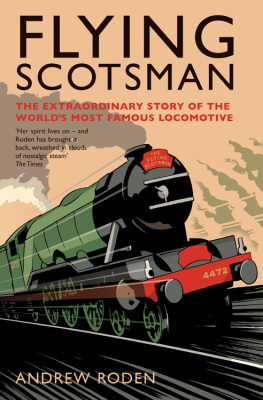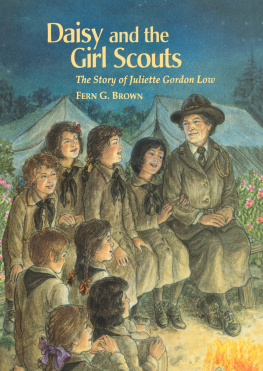Contents
Id like to acknowledge the help and assistance of a number of people, without whose efforts this book simply wouldnt have happened.
Firstly, I must thank my good friend and colleague Mike Wild, who has been a sounding board for the book from the start, and who generously stepped in to undertake some interviews at a time when I was unable to. His knowledge and expertise particularly of the post-1996 period have been crucial.
Others have been just as important. Nick Piggot, the editor of The Railway Magazine, has been an enthusiastic supporter of the book, and his interviews with Alan Pegler in particular as well as his vast knowledge of everything to do with Flying Scotsman must now be seen to be a vital part of the historical record.
Thanks also must go to the Hon. Sir William McAlpine, Bt (to give him his full title), who at very short notice made time in his schedule to invite Mike and me to his home and share his experiences of what it was like to own the most famous locomotive in the world.
The National Railway Museum has been marvellous, and hearty thanks must be offered to Andrew Scott, Helen Ashby, Bob Gwynne, Camilla Harrison, Tracey Parkinson, Jon Pridmore and all the wonderful staff in the archives who pulled out the stops (and quite possibly some hair too) to share their material even when their whole archive was being reorganised.
Ken Issitt and Colin Churcher have been extremely generous with their time, sharing their experiences of life on the footplate and giving those of us too young to remember steam in the wild an appreciation of just how difficult and, in Issitts case, downright dangerous their jobs could be. They, and all the other railwaymen and women in the book, are heroes.
Thanks, too, to the editor of that most esteemed of American rail enthusiast magazines Trains, Jim Wrinn, who put me in touch with a number of people who saw Flying Scotsman during its stay across the Pond.
To my partner Jenny who has put up with hours of pacing the carpet, drafting sections of the book aloud thank you for putting up with it. To my colleagues on International Railway Journal, thanks, too, for your forbearance.
To anyone whose contribution Ive failed to acknowledge, please accept my sincere apologies: I have valued all contributions to the book, great and small.
Final thanks must go to my Publisher at Aurum Press, Graham Coster, Phoebe Clapham (who oversaw the early stages of the book), the managing editor, Nithya Rae, and the editor, John Wheelwright: their encouragement (even down to taking the Night Riviera sleeper to see me in Cornwall!) and support have been fantastic.
In the early-1950s, Flying Scotsman, the worlds most famous steam locomotive, was sent from her old stamping grounds on the line north from Kings Cross to help haul passenger trains from Leicester to London Marylebone on the old Great Central line.
One day, she was rostered to take over the Sheffield to Marylebone South Yorkshire Pullman from Leicester to the capital. It was a fairly routine duty, and although an extra couple of coaches had been added as it was a public holiday, it was well within the capabilities of this Brunswick-green racehorse.
Problems had been reported with Flying Scotsmans injectors the day before, but by the time the young fireman, Ken Issitt, joined the locomotive at the Leicester shed they had been resolved.
The Gresley-designed locomotive rapidly gathered pace on her way south from Leicester, getting to grips with her load, and cantering down the flat and level Great Central Main Line. Soon after it passed Charwelton in Northamptonshire, however, the right-hand injector began to leak water, a sure sign that something was awry. Flying Scotsman would normally have been able to keep pace with the steaming rate on just one injector, but Issitt kept having to supplement it with short bursts from the left-hand injector. Things got worse, and the right-hand injector failed completely just after the train went past Aylesbury. Although this wasnt dangerous, it meant that Issitt and Cyril Chamberlain, the driver, would have to work hard to conserve steam in order to avoid draining the boiler.
The situation worsened further. The left-hand and hitherto reliable injector started playing up. Issitt tried everything he could think of to get it working, but as the train passed Wendover, near Aylesbury, that too failed. With no way of getting water into the boiler, things were looking serious. By now, Issitt had stopped firing, but the burning coals in the firebox would boil all the water away, and that could lead to only one thing: a catastrophic boiler explosion. Drastic action was called for.
The fire had to come out pretty damn quick, recalls Issitt. Bear in mind that theres something like 41 square feet of grate area in the firebox and at least two tonnes of burning coal in there, and you can see the problem we had.
I began winding the grate down while Cyril struggled with the injector. He set the engine coasting with the regulator barely open.
Issitt took the long fire shovel from the tender and started pushing the fire from the firebox into the ashpan. As Flying Scotsman continued running, burning coals showered from her underside as if she was bleeding. The vegetation on the embankments and cuttings despite being well tended was soon ablaze.
The two men were doing everything within their power, and Issitt pushed himself to the limits of exhaustion frantically trying to remove the heat source from the boiler in order to save their locomotive and the passengers on the train.
The fire shovel was beginning to become soft and bend with the heat. The water level had disappeared in the glass. We looked anxiously into the firebox to see if the lead plugs in its roof had melted, and for the telltale hiss of steam telling us how near we were to disaster and the need for us to run for our lives. We were seconds away from oblivion.
Unless Chamberlain could get the injectors working and get water into the boiler, the lead plugs in the firebox roof would, as Issitt points out, melt, venting steam into the firebox to warn the crew of danger and relieve the increasingly explosive pressure. However, this would be no solution merely a way of buying the crew a few precious extra seconds. After the lead plugs had melted, the water would fall below the copper surface of the inner firebox, which ordinarily was kept from melting only by the water that surrounded it absorbing the heat. If the firebox had started to melt, the boiler would have been completely out of control. Anything could have happened it could have imploded, sending the white-hot steam back into the cab and the train; it could have exploded, sending the boiler flying off Flying Scotsmans chassis; or any one of a number of other catastrophes could have wrecked the engine. The only certainty is that Issitt and Chamberlain and many of their passengers would have been killed or seriously injured.
With the train now coasting at 40mph, Chamberlain continued to hammer, kick, coax and curse the injectors. There seemed nothing wrong with them. He and Issitt needed a miracle.
They got one: suddenly the injectors started to pick up water and send it into the boiler. There was no rhyme or reason for it, but Chamberlain wasnt going to worry about that for the moment. He shouted across to his mate: Ive got it working!
Thank God, said a relieved Issitt.
Flying Scotsman was nursed to London, arriving just five minutes late. She was clearly not in a fit state to return to Leicester until the problem had been sorted once and for all. Issitt was sufficiently intrigued by the days difficulties to find out what had caused them. There was nothing wrong with the injectors. They separated the engine from the tender for inspection and found algae and rust had blocked the strainers in the tender.
Next page
















